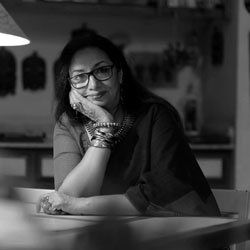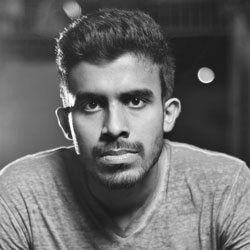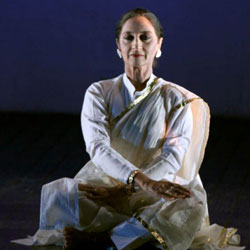2017 Karachi Biennale Artists
Roohi Ahmed
Born in 1966 in Karachi (Pakistan)
Lives and works in Karachi (Pakistan)
Roohi Ahmed is a multi-disciplinary artist; her work often draws upon cartographical references in order to investigate the ontological realities of human existence, in a degenerative socio-political and cultural climate. Ahmed is an Associate Professor at the Indus Valley School of Art and Architecture, Karachi and holds an MFA from the University of New South Wales, Sydney (UNSW Art & Design). She has exhibited widely in Pakistan and internationally, her work having been featured in the 11th Asian Art Biennial, Dhaka. Ahmed has coordinated the Foundation Programme at IVS, as well as having lectured at the University of Karachi’s Visual Studies Department and UNSW Art & Design, Sydney. She has participated in various international artists’ workshops, including: Britto (Bangladesh); Vasl (Pakistan); and Coast (U.K.), and has also been an artist in residence at Cicada Press (Australia), Coast (UK) and VASL (Pakistan). As well as art-making, Ahmed has curated Simply Paper! and her co-curating credits include: Michael Esson: A Survey of Drawing; Michael Kempson: A Survey of Prints, Aboriginal Dreams, and Let’s Draw the Line; and 6X6: The Labyrinth, in Karachi. Ahmed’s art practice investigates an individual’s relationship with society, and the space in which the two co-inhabit. Borrowing from the conventions of map-making and sewing, her work challenges a purely static notion of such a space to promote a temporal logic that reflects our fluctuating interrelationship with the invisible infrastructures that comprise our societal framework.
Ahmed’s work for the Karachi Biennale 2017, Encounters of Another Kind, constructs a narrative using the human figure as an interpretative tool to perceive the world. Ahmed delineates the way in which the sewn figures, eerily resembling body-bags, enable this perception: “Every mark I make articulates a response to the world around me. For me mark-making can be interpreted through the act of sewing. By relocating and bringing together different elements, their meaning and use is transformed and re-contextualized.” The sculptures are thus Ahmed’s highly personal response to the world, manifested in the act of sewing, but they also simultaneously embody an expression of physical histories as shaped by divergent narratives and contexts, forming a collective, and somewhat equivocal unconsciousness. A further layer of complexity is added when one considers the viewer’s interpretation of these objects; each a unique perspective on Ahmed’s personal response to the world around her, hence diversifying the reach of her sculptural installation.
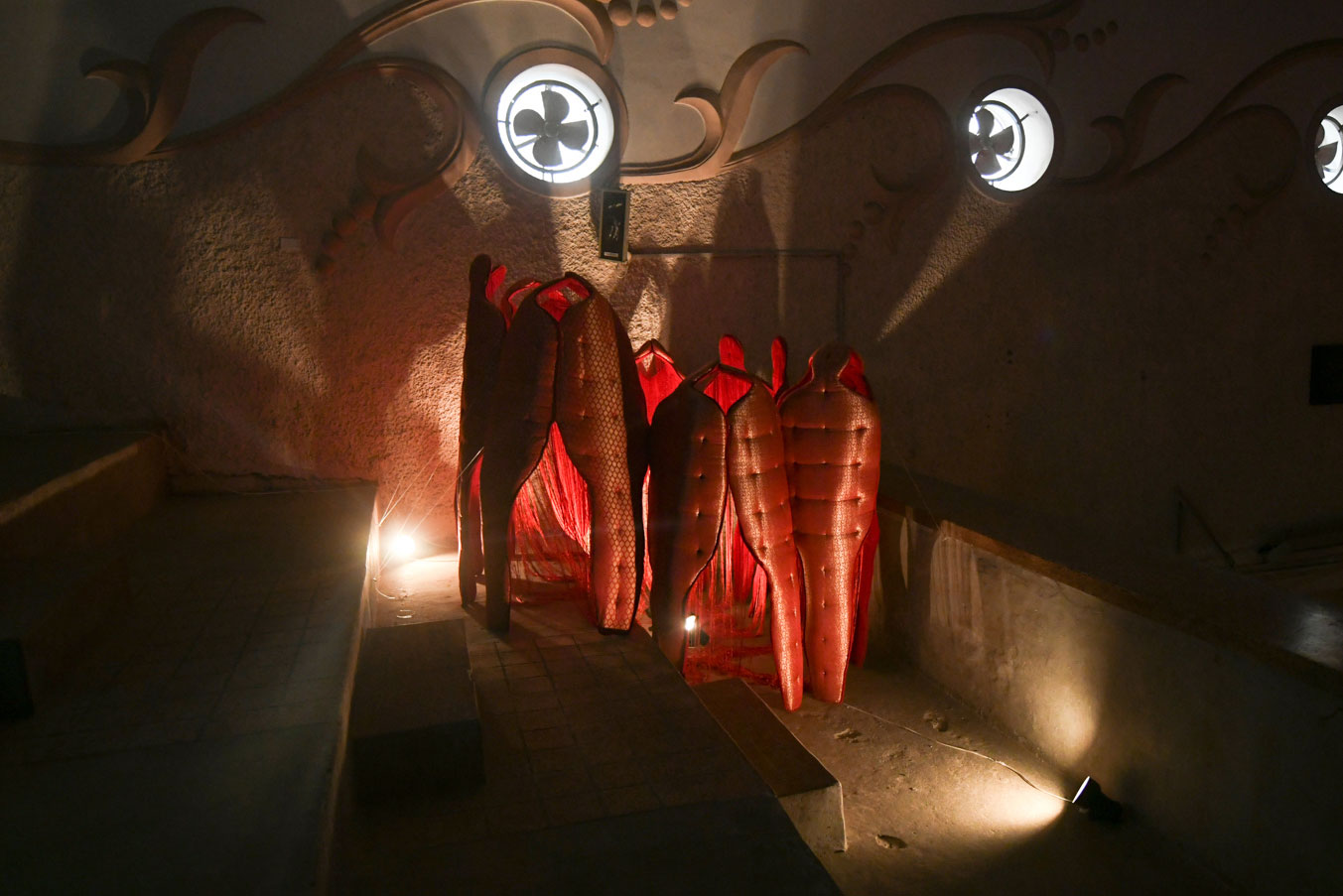
Encounters of Another Kind, 2017.
Banarsi fabric, velvet, polyester filling and metal
Approximately 56 x 157 cm. each
Roxana Nagygellér
Born in 1963 in Alajuela (Costa Rica)
Lives and works in San José (Costa Rica)
Roxana Nagygellér received a Diploma of Photography Arts and Sciences from the College of Alajuela, Costa Rica in 1997. She has also carried out independent studies of photography, videocreation, politics and cultural management, installation and set design, traditional and artistic "bindings," as well as the history of art and philosophy at various museums and artistic production centers, including the University of Costa Rica and the Cultural Center of Spain. She has produced editorial, documentary and commercial photography for several magazines. The artist has had six solo exhibitions and has participated in more than 30 group shows of photography and video in Costa Rica, France, the Dominican Republic, the Netherlands, Mexico, Guatemala and Nicaragua. She was selected for the Central American Biennial of Visual Arts in several editions, as well as for other national and international competitions
Roxana Nagygellér has submitted photographs from her series Letters to Nicolas for KB17. This is a series of portraits of migrant men in Costa Rica. This is a continuation of earlier work in which she explored the migrant experience for women. That series, entitled People in their Place, was an easier task for the artist. She states: “The work with women was fluid and fun for me. In Letters to Nicolas the approach to strangers was more complex. I felt more questioned, more watched. It was more difficult to break the ice with men. I converted the photographs into diptychs, generating a dialogue between texts, clouds and portraits. The letters are like messages carried by the wind. Written by migrant children from slums in the capital, they attempted to answer the questions: Who am I? Where do I come from? These are questions we all ask ourselves at some point in our lives.”

Letters to Nicolas I, II and III, 2001.
Digital photograph
61 x 46 cm.
Courtesy the artist
Curated by Carlos Acero Ruiz.
Ruby Chishti
Born in 1963 in Jhang (Pakistan)
Lives and works in New York (USA)
Ruby Chishti is primarily a representational sculptor. Her work is largely autobiographical in nature. Ruby was formally educated at the National College of Art in Lahore, Pakistan. Over the past 17 years, she has produced a series of lyrical sculptures and installations that touch on such issues as Islamic myths, gender politics, migration, memory, universal themes of love, loss and of being human. Ruby’s early life was marked by pain and the recurring losses of loved ones. As a young woman, the experience of caring for her inert mother for over a decade deeply impacted Ruby’s psyche and practice – this internal experience found its echoes outside in the repressive political climate of Pakistan during the regime of General Zia ul Haq (1977-1988). Her work has been exhibited, among other places, at Taubman Museum, Queens Museum, Art Asia Miami, Arco Madrid (2010), Art Hong Kong (2008), India Art Fair (2013), The Armory Show NYC (2014), and the Asia Society, New York (2017). Her work can be found in the collections of the Devi Art Foundation, New Delhi, India; Harris Museum Preston, UK; V&A Museum of Childhood, London, UK; Whitworth Art Gallery, Manchester, UK and elsewhere.
Ruby Chishti writes the following of her installation created for KB17: “Architecture bears witness to historical acts of domination, manmade atrocities and political violence. We Leave, We Never Leave, We Return Endlessly is an abstract form that appears to be a distorted world map as if drawn from memory, suspended from the ceiling. The overall form is a juxtaposition of architectural and human body structures, a witness of lives ripped and rebuilt, where I see links to personal and political narratives. It is a framework I use to explore the codependent relationship between personal experience and the socio-political narratives amplifying the voices of those who have survived emotional and physical trauma resulting from conflict, war and the universal subject of mortality. The work is an audiovisual installation created from unknown people’s clothing…I am interested in exploring the function of clothing that is beyond social status or sexual and cultural differences. It is my way of engaging with the persistence and tenuous fragility of human existence, while exploring materials and reinventing sculptural forms that can forge a sense of collective human connection.”
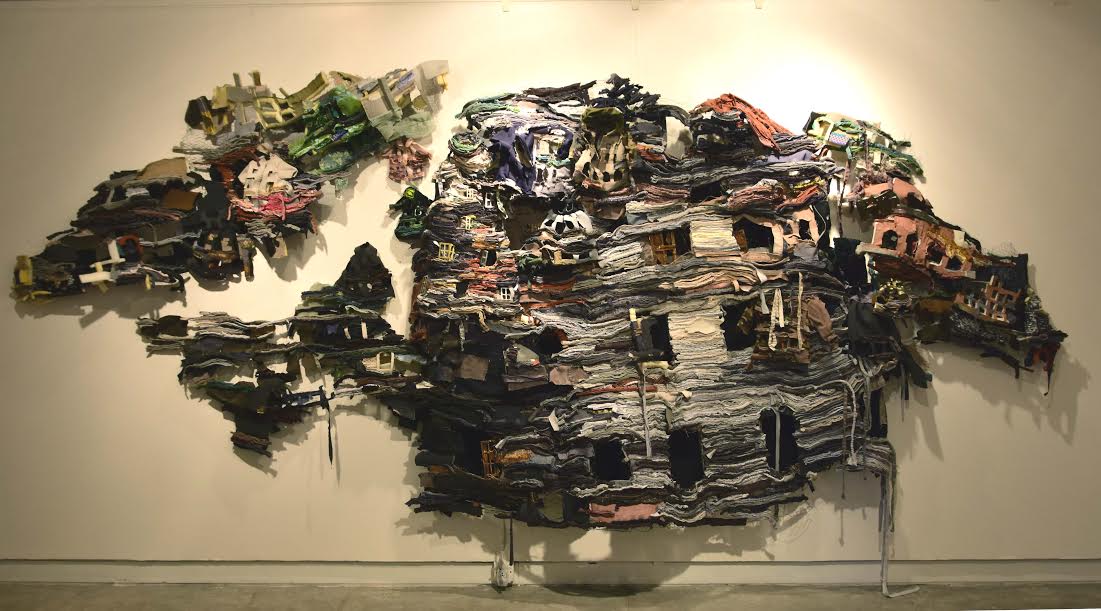
We Leave, We Never Leave, We Return Endlessly, 2017.
Recycled textile, wire mesh, thread, wood and archival glue.
210 x 330 x 35 cm.
Courtesy the artist
Rumana Husain
Born in 1952 in Karachi (Pakistan)
Lives and works in Karachi (Pakistan)
Rumana Husain is the author of Karachiwala: A Subcontinent within a City (2010) and Street Smart: Professionals on the Street (2015). She has written and illustrated over 60 children’s books and developed numerous teachers’ manuals for several publishers including Oxford University Press, Danesh Publications, ERDC, Kathalya Publications (Nepal), Nami Children’s Books (South Korea), Butterfly Works (The Netherlands), Pratham Books (India), and the Bookgroup, which she co-founded in Karachi in 1988 and was its Director from 1996 until 2000. Husain trained as a graphic designer but has had an evolving career: from teaching art to making fabric-toys and quilted artwork, as an innovative school head, teacher-trainer, book illustrator and writer. She also contributes reviews and articles to national newspapers and magazines. She co-founded NuktaArt, a bi-annual art magazine, published for ten years, of which she was Senior Editor. She worked as Head, Activism & Outreach at the Children’s Museum for Peace and Human Rights from 2001 to 2008, and was teaching at and also heading the CAS School from 1986 to 1996. She is an Honorary Director on the Board of the Children’s Literature Festival (CLF), Honorary General Secretary of the Karachi Conference Foundation and a Founding Member and Member of the Executive Committee of I AM Karachi – a social movement.
She writes of her performance for KB17: “Karachi has been my muse for as long as I can remember. I would like to portray this city’s diversity by donning various head covers and dopatta worn by Karachi women. The various head gears, placed on a wooden rack, will be put on for a minute or two each. The following will be at my disposal: A shuttlecock burqa worn by many Pathan women; a white embroidered chaadar worn in particular by Delhi Saudagran women; a black abaya worn by Shia women of Iranian origins; a ‘Marvi’ dopatta worn by women of Thar; a ‘rida’ headgear worn by Bohra women; a tie-dyed chunri over my head; a net dopatta over my shoulders; a glittery, studded abaya worn by many Sunni women; a hijab covering my hair; a saree pallu over my shoulder worn commonly by women from different backgrounds; a saree pallu in the front like the ones Parsi and Gujarati women wear; a scarf tied over my head like a turban (it’s the new trend); and a chuna-huwa single-coloured dopatta around my neck.”
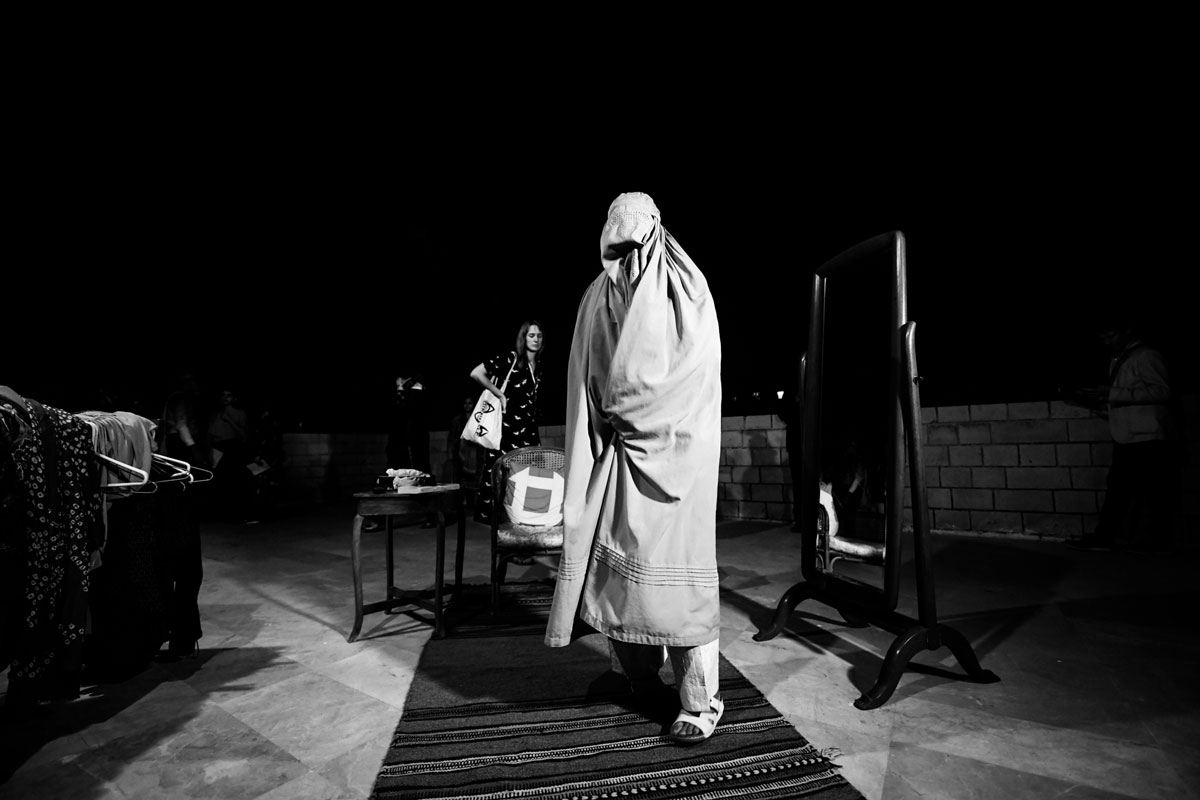
The Many Faces of a Karachi Woman, 2017.
Performance
Saba Khan
Born in 1982 in Lahore (Pakistan)
Lives and works in Lahore (Pakistan)
Saba Khan completed her BFA from the National College of Arts, Lahore, (Distinction), and MFA from Boston University, on a Fulbright Scholarship. Synthesising painting and object-making in her art practice, her work is saturated with satirical humour, exploring class divisions and proscribed social structures through layers of endemic aesthetics, yet without sermonising or moralisation. Connotative visual motifs characterise her acerbic commentary on socio-political conditions, exemplified by her use of gaudy palettes, glitter and diamantes to comment on the upper-classes, along with the ceremonial, residential and mercantile ostentatiousness that they display. Khan has exhibited her work throughout the world, including: SAVAC, Toronto; the Khatmandu International Art Festival; the Lawrie Shabibi Gallery, Dubai; the Bangkok Art and Culture Centre; the Affordable Art Fair, New York; the India Art Fair; and the Aicon Gallery, New York, as well as two solo exhibitions at Canvas Gallery, Karachi and at Taseer Gallery, Lahore. She has participated in a wide variety of residencies, and is a published writer. Currently, she teaches at her alma-mater, the National College of Arts, and founded the Murree Museum Artists’ Residency, an artist-led initiative to support artists and writers, in 2014.
The title of Saba Khan’s sculptural installation for the Karachi Biennale 2017, [Begum-sahiba after her diet ] Sheer-Maal – Sweet Delights, inspired by the eponymous pastry-like flatbread implying a certain dietary decadence, epitomises her culturally-attuned, incisive satire. Khan appropriates and vulgarises the embellished frames of Punjabi-Baroque chairs, yet their voluptuous mass, almost bursting at the seams, becomes a burden of their own excess. The subtle acidulousness of Khan’s satire means that the bloated chairs not only symbolise elite authority and excess - the kitsch, blushing pink stuffing and the meretricious frames also reference the exhibitionistic excess and elitism of the emerging nouveau-riche, synthesising an acute commentary on the class divide.
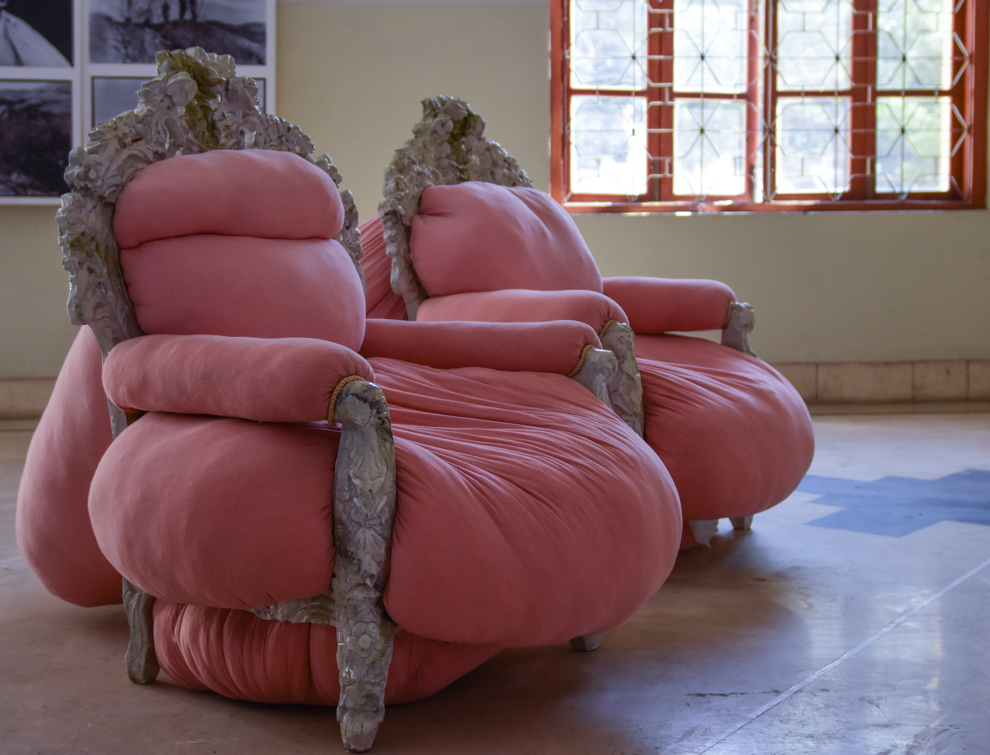
Begum-sahiba after her diet, 2012.
Wood, fabric, paint and polyester filling
Approximately 100 x 100 x 100 cm each

Sabah Husain
Born in 1959 in Peshawar (Pakistan)
Lives and works between Lahore (Pakistan) and Boston (USA)
Sabah Husain
Born in 1959 in Peshawar (Pakistan)
Lives and works between Lahore (Pakistan) and Boston (USA)
Sabah Husain is a visual artist and curator. She received her B.F.A from National College of Arts, Lahore and M.F.A from Kyoto University of Fine Arts and Music, Japan, in 1988. During the period 2014-15, she conducted her Post Doctoral Research and Studio Practice at the School of Museum of Fine Arts, Boston, USA. She has held various group shows at: the School of Museum of Fine Arts, Boston; Kyoto City Museum, Japan; Victoria and Albert Museum, London; Asia Pacific Museum, California; and the National Art Gallery, Islamabad, Pakistan. Selected solo exhibitions were held at: the Embassy of Pakistan in Washington DC, 2015; Yamaso Art Gallery, Kyoto; and October Gallery, London. Her works are in the collection of National Art Gallery Pakistan, Permanent Collection of the U.S Embassy Islamabad, [AIE] Pakistan, Victoria and Albert Museum, British Museum and Bradford Art Galleries and Museums, U.K and Okinawa Museum, Japan. In 2004, she was awarded the Japan Foundation Fellowship. In 1996, she received the National Excellence Award at the 7th National Exhibition of Visual Arts, Islamabad Pakistan. In 1987, at the Kyoto Museum Exhibition, she received the Musrasaki Award. From 2000 to date, she has served as Adjunct Faculty, Department of Fine Arts, M.F.A, National College of Arts Lahore. Her artistic practice draws from a wide range of influences, with music and poetry remaining pivotal to her work.
Husain’s work for the Karachi Biennale 2017, Nur Jahan, is an homage to the eponymous Mughal Empress, epitomising the artist’s multi-medial approach. Husain explains the importance of the aesthete who ruled India: “She was a remarkably powerful influence on the aesthetics of her age. Nur Jahan's narrative is unique because she did not conform to the established ideals of a woman of the time and stood outside the realm of traditional Indian prototype. Her story is one of political dexterity, military competence and numerous cultural achievements.” In Nur Jahan the artist has referenced three architectural structures which she patronized and designed: her father, Itamad ud Daulla's garden tomb in Agra; the Nur Afshan river-front garden on the River Jamuna in Agra; and her own tomb in Lahore, on the banks of the River Ravi. Husain has used the plans of these gardens and tombs, maps of the cities and the architectural embellishments to create a visual narrative in coloured glass, in conjunction with a concurrent strand derived from Nur Jahan's portraits, images of her royal decrees and the coins minted in her name, using embroidery and Kozo paper. Husain’s work addresses the erasure from collective consciousness of the only Mughal Empress of India, whose accomplishments in the arena of arts equal, if not surpass, those of most men who ruled India.
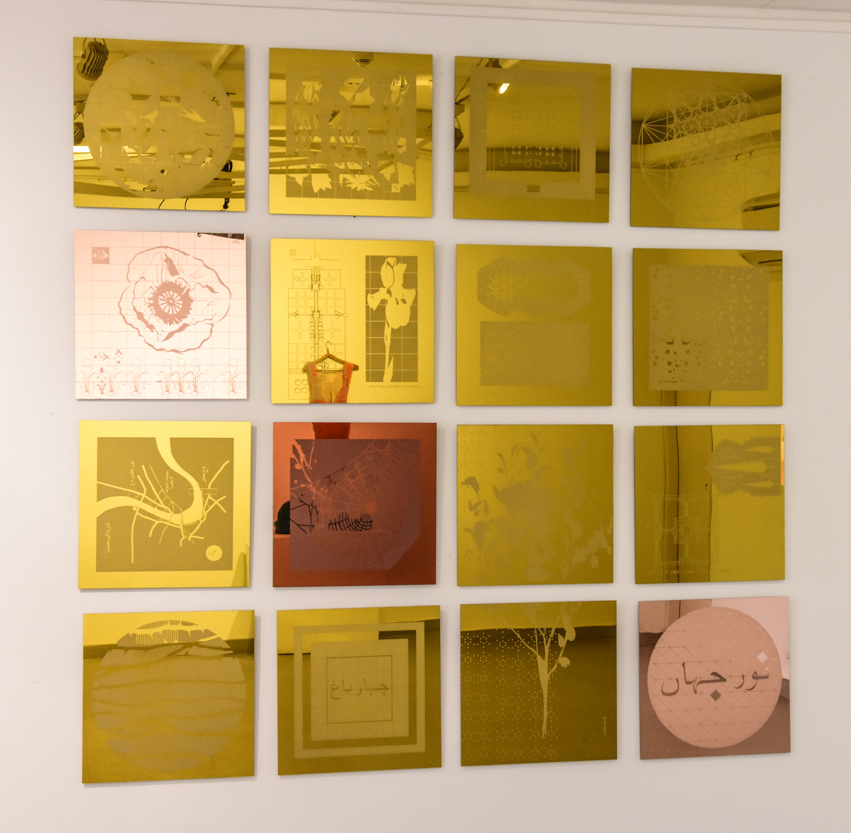
Nur Jahan, 2017.
Glass, handmade paper (kozo, mitumata, gampi fibres), sumi, acrylic paint and embroidery
243.84 x 121.92 cm, 121.92 x 91.44 cm.
Courtesy the artist
Sabine Bachem
Born in Oldenburg (Germany)
Lives and works in Reasfeld (Germany)
Sabine Bachem is a German artist who grew up in Mexico and England. She attended the Michael Hall School in East Sussex, whose core focus is on arts and crafts. As Bachem recalls of those formative years, “This was the perfect place for me having had to learn three languages by the time I was seven and, therefore, finding language an unreliable source of communication, discovered art to be a very safe environment to reap and gather life’s secrets. From that time on, I have made art to understand. Through my work, I examine the structure of the human mind, which continually fascinates me. I search for images that on the one hand reflect the narrative, i.e. the translation of reality into a story, and on the other hand reflect the zone that appears when culture nudges up against nature. Both these states of human psychology create an art-ificial (in German‚ kunst-lich) reality. My media are painting and drawing.”
Sabine Bachem has submitted two drawings for KB17. She writes, “The portraits are images I have downloaded from social media sites that I have paired up with landscapes altered by culture in an attempt to create a narrative.”

Amruts, 2017.
Graphite, acrylic, charcoal on 230 gram paper
122 x 169 cm.
Courtesy the artist
Sadia Salim
Born in 1973 in Hyderabad (Pakistan)
Lives and work in Karachi (Pakistan)
Sadia Salim graduated with a B.Des from the Indus Valley School of Art and Architecture (IVS), Karachi, and completed her Ed.M. in Art and Art Education at Columbia University, New York. She is a practicing artist and recipient of the Commonwealth Arts and Crafts Award and Fulbright Scholarship. She has been part of conferences, residencies and exhibitions in Pakistan as well as internationally. Salim has extensive experience in teaching art and design at the undergraduate level including coordinating the Department of Ceramics at IVS (2005 - 2010). Currently she is Associate Professor and teaches in the Department of Fine Art; she also writes essays on art and craft in newspapers, catalogues and journals.
Of her work for KB17, Sadia Salim states: “A brick – a found object, ubiquitous and functional, centuries old or new, quiet and observant, made by hands of an unknown person and stamped with a factory’s logo. Within its mass, and as Antony Hudek asserts, ‘is a trove of disguises, concealments, subterfuges, provocations and triggers that no singular, embodied and knowledgeable subject can exhaust.’[1] Therefore the site specific brick installation proposes nothing to the viewers through the words of the artist, enabling them to witness, sense, interpret, and make meaning of the visual. However, as these reticent objects stare back at us, they witness us and our lives, and those who came before us or will come after. What is it that we want these objects to see and interpret?”
[1] Detours of Objects – Antony Hudeck

Untitled, 2017.
Clay brick, glazed and Raku fired
Dimensions variable
Courtesy the artist

Salman Jawed/Faiza Adamjee/Ali S. Husain/Mustafa Mehdi/Hina Fancy/Zaid Hameed
Live and work in Karachi
Salman Jawed/Faiza Adamjee/Ali S. Husain/Mustafa Mehdi/Hina Fancy/Zaid Hameed
Live and work in Karachi
Salman Jawed is co-founder of Coalesce Design Studios, a house of multidisciplinary designers that go beyond form and function to interpret an intangible into a tangible built product. Faiza Adamjee is a concept writer and thinker. She focuses on big ideas, concepts and copywriting, along with graphic designing. Ali S. Husain is a Karachi based graphic designer. His style is illustrative, minimalistic, and edgy. He has recently launched a line of paper products, which aim to change the face of graphic design in Pakistan. Mustafa Mehdi is an architect by profession, who also practices graphic design, photography and product design. He is co-founder of Coalesce Design Studio. Hina Fancy is a textile designer, who works as a teacher and independent print designer. Famous for her unique style of experimental printing with natural dyes, she has exhibited her art in Pakistan and abroad. Zaid Hameed is a textile designer by profession, celebrating the indigenous crafts of Pakistan. He fuses traditional techniques and patterns with contemporary techniques and forms, helping to revive the dying art of ceramics in Sindh. They are a group of six independent designers, working together to redefine design, and the merging of the arts. From representing Pakistan at the Dubai Design Week 2016, to exhibiting their idea of Utopia at the London design Biennale, and putting up an installation at the Alchemy Festival in the Southbank Centre in 2017, the group is setting new standards internationally.
The artists write of their work for KB17: “Daalaan is an abstract playground where visitors are invited to revisit the utopian worlds they create as children. A place where anything is possible. A space without borders, where imagination has no bounds. Where people get together, and enjoy a playful moment in time... a setting where strangers become friends. The pieces evoke conversation. A setting that is incomplete without its participants, each one is designed to make people interact through play. The space is an open platform that is inviting to ideas and change. Feel the nostalgia, evoke the memories, and become a child. Leave all inhibitions behind. Rethink how you have changed, how you can change back, what was, what is, and what should be.”

Daalaan, 2017.
Silk, wood and metal
Dimensions variable
Private collection
Samina Islam
Born in 1966 in Karachi (Pakistan)
Lives and works in Karachi (Pakistan)
Samina Islam is a mixed-media artist who was born to a Pakistani father and Dutch mother. When she was four years old, she moved to The Netherlands where she spent her next twenty-five years. Being exposed to two opposite cultures, Islam has always been intrigued by people, traditions and surroundings. The quest for self, through her art, is an ongoing process for her. Islam moved back to Pakistan later in life where she started her endeavors in art. She got her Fine Art Diploma in 2002 with Distinction from Studio Art. She pursued her love for photography by attaining a Photography diploma and incorporating photography in her art practice. She incorporates needlework on top of her images, which are printed on cloth. Islam enjoys experimentation and works with various media to achieve the effect she is looking for. She has exhibited nationally and internationally and has been part of a textile art residency in Oaxaca (Mexico) and Studio Kura residency in Fukuoka (Japan). She lives and works in Karachi, where she heads the Art Department of Karachi Grammar School (College section).
For her work on view at KB17, From Within, the figure of a young girl is seen floating in front of a tree. Islam states, “She is in a moment of nirvana, a transcendent state in which there is no suffering, desire, nor sense of self, and she is released from the effects of karma and the cycle of death and rebirth. Her body is transparent as if she floated out of her earthly body and became part of another universe.” For this work, Islam photographed an old tree she saw in Karachi. The artist believes trees have a mysterious and spiritual aura, which she wished to emphasize through the color green. From the flat, processed photograph, an image of the artist’s daughter emerges. Her dress is formed by net textile, its folds stitched by the artist’s own hand. Islam states, “In some way I am projecting myself through her.”

From Within, 2017 (Detail).
Textile and thread on inkjet on canvas
129 x 183 x 3 cm.
Collection of the artist
Samra Roohi
Born in 1990 in Karachi (Pakistan)
Lives and works in Karachi (Pakistan)
Samra Roohi received her BFA (Honors) from Karachi University, Department of Visual Studies in 2012. She has participated in numerous group shows, including “Awaaz: Baldia Factory Inferno,” Karachi Arts Council; “All Puns End with Guns,” Rohtas Gallery, Islamabad; “Pursukoon Karachi,” Karachi Arts Council; “FRESH!” Amin Gulgee Gallery, Karachi; “Dil Phaink Alchemy,” South Bank Centre London, UK; “Unwritten Thoughts,” IVS Gallery, Karachi; “The 70's: Pakistan’s Radioactive Decade,” Amin Gulgee Gallery, Karachi; “We the People,” Sadeqauin Gallery, Frere Hall, Karachi; and “Ibtidah,” Studio Seven Gallery, Karachi. She is the recipient of the Art Commendation Award by Ladiesfund and a scholarship by VM Art Gallery.
Samra Roohi writes of her lenticular print on view at KB17: “My work talks about changing perceptions. I use others’ ways of presenting reality and manipulate it according to how I perceive it. My work debates the actual projection of what is happening in our society, but it only provides you with a picture. How you perceive it depends upon who you are.”

Untitled, 2012.
Lenticular print
122 x 92 cm.
Courtesy the artist
Sanki King
Born in 1990 in Jeddah (Saudi Arabia)
Lives and works in Karachi (Pakistan)
Sanki King is a self-taught street artist, pioneering the bourgeoning discipline in Pakistan. He is a member of two of the most respected graffiti crews in the world: BMK (Beyond Mankind Krew), established in 1991 in Queens, New York; and Ex-Vandals (Experienced Vandals), established in 1978 in Brooklyn, New York. Since 2012, Sanki King has produced some of the largest single-artist works of graffiti in Pakistan, creating work in seven different languages to date. In 2015, his work was published in a book of global street art, Street Messages by Nicholaz Ganz, which also includes the artwork of world-renowned street artists, such as Banksy, El Seed and Ben Eine. He has also given a number of talks around Pakistan, most notably at: the Young Leaders Conference, Karachi; TEDxNustKarachi; and TEDxNEDUniversity. Sanki King’s work has been exhibited at Sanat Initiative Gallery, Karachi; VM Art Gallery, Karachi; the 1st Sindh Literature Festival, Karachi and Soul Patch, Mumbai. King will feature in Season Three of Interrupt This Program, an award-winning Canadian series of television documentaries exploring ‘underground’ art scenes. King’s artistic practice derives its inspiration from textual structure, linguistics and literature, manifesting itself in an ever-modulating style which could most often be described as a kind of futuristic street calligraphy.
In Sanki King’s site-specific project, Mind Palace, which inhabits and unfurls itself across the rooftop of The Theosophical Society, he has taken the location and its interaction with his graffiti to be a representation of his mind, deliberately exposed and made public. In fact, the architectural context of the rooftop, as surrounded by dilapidated apartment blocks, entails that the audience for the work is very much the public – the local residents who have witnessed the entire process of the realisation of King’s work. The painting, osmotically diffused throughout the rooftop’s topography, is based on writings of King’s own composition, collectively entitled Freedom of Thought. The work openly enters into multifarious dialogues: with its setting and the context of Karachi; with the concept of exhibition space; with preconceived definitions of art genres, especially street art and calligraphy; and with the viewer, in that it allows them access to the artist’s internal thought process, creating a discourse between the two divergent internal perspectives. The viewer, in a literal sense, is able to enter, walk and exist within King’s artistic representation of his consciousness, his psyche, his Mind Palace.
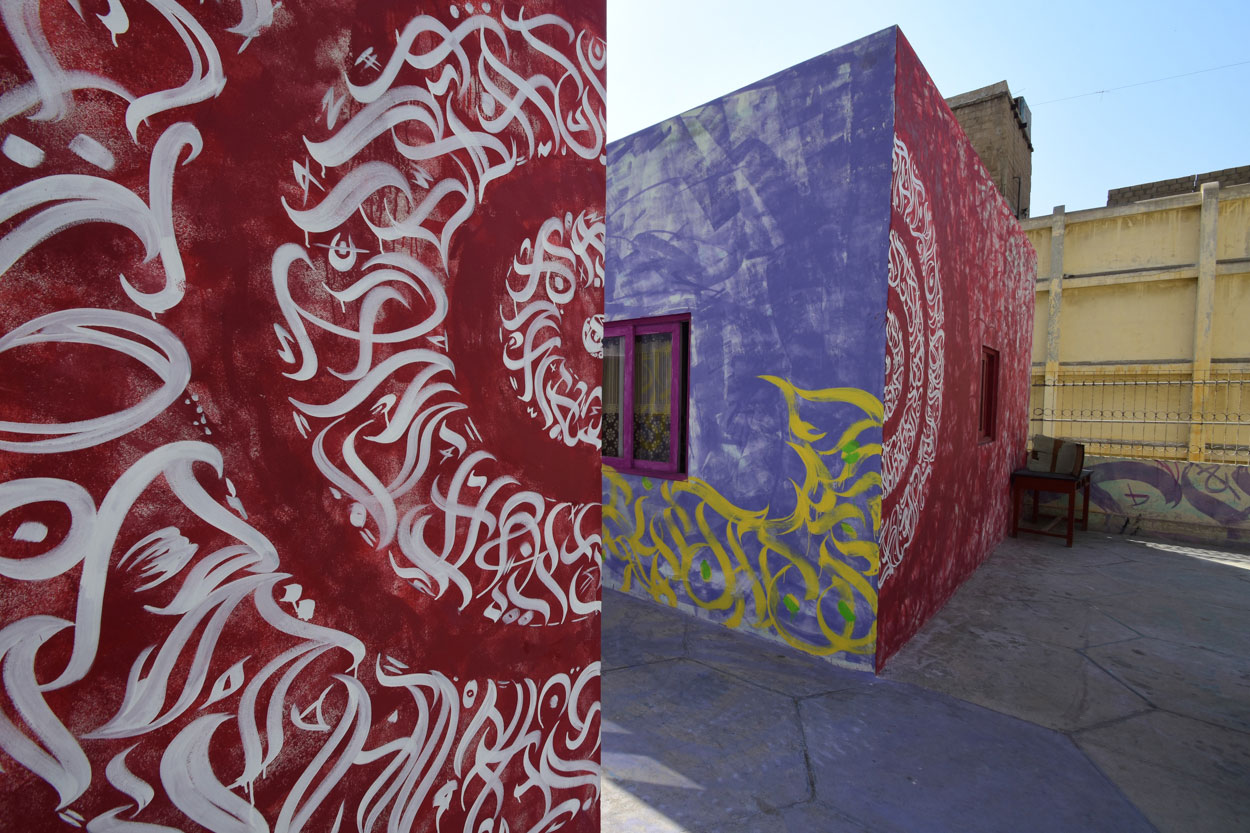
Mind Palace, 2017.
Grafitti
Sara Roitman
Born in 1953 in Santiago (Chile)
Lives and works in Quito (Ecuador)
Throughout her trajectory as a photographer, Sara Roitman has incorporated video art, installation, objects, neon, embroidery and sewing into her repertoire of artistic practices. Her work is about creating and rearranging spaces of reflection and speculation. Her work has been exhibited in Ecuador, Cuba, the Dominican Republic, Israel, the US and Singapore. In 2009 she published IMPERDIBLE, a photographic book of her artwork that won several international awards, including the Gold Medal, Sappi in Johannesburg, South Africa. Her artworks are in private collections and in public institutions.
Sara Roitman writes of her work on view at KB17: “Combining works of different series under a single title is not uncommon in my artistic practices. I have been working with the human body for many years from different aspects and perspectives. I picture the geographies of bodies; I picture the body as territory; I displace the body and make it fade. The photographic works: S/T I and S/T II portray the body after the soul abandons it. The portrait is an attempt to shape a body and its soul fading away and the emptiness that is perceived in its displacement. In the works Territorios I and Territorios II I create fictional geographies of the same bodies that make us doubt if it is about more than one person in the same territory.”

S/T I, 2016.
Photograph
70 x 105 cm.
Courtesy the artist
Curated by Carlos Acero Ruiz.
Sarah Revoltella
Born in 1971 in Geneva (Switzerland)
Lives and works in Venice (Italy)
The performance Io Combatto ("I Fight") arises from the idea that the artist can flip the destructive function of weapons by destroying weapons in turn. The “object” that has been created with the purpose of destroying the life of men reveals itself at the end to be an empty crock, broken and unusable as the wreckage of houses, villages, environments which remain the only evidence, the only "survivors" of bombings. Breaking weapons into a thousand pieces symbolically evokes the madness that results from the ephemeral act of killing and destroying “for its own sake”. The work starts with the ceramic exact replica of a number of weapons that are used in contemporary wars (machine guns, pistols, mines, rifles, etc.). The artist, with the help of experienced potters, created this small arsenal. The performance consists then of the exhibition of weapons to the public: each weapon is illustrated and explained in detail in all its specific and lethal characteristics. During the second part of the performance, the weapons are destroyed by the artist who creates a sort of "symbolic bombing" where the weapons, and not mankind, are the objects of destruction. The broken pieces that remain on the ground form the final work. At the end of the performance, the only visible ruins are formed by the weapons themselves, that will operate a symbolic “upside down” of the "natural” purpose they were created for. Eventually the broken pieces are installed / planted like flowers in a meadow.
Video documentation of Sarah Revoltella’s Io Combatto will be reshown at KB17. The original simultaneous performance was curated by Olga Gambari and made in collaboration with Terzo Paradiso, the foundation Pistoletto and the support of Veneto Region, the municipality of Nova, the Department of Culture of the Municipality of Nova, Vicenza province and the city of Venice. The performance artists were: Sarah Revoltella (Venice); Hermes Zaigott (Moscow); Burçak Konukman (Istanbul); Sean Donovan (New York); Sara Pagganwala (Karachi); and Colette Nucci (Paris).
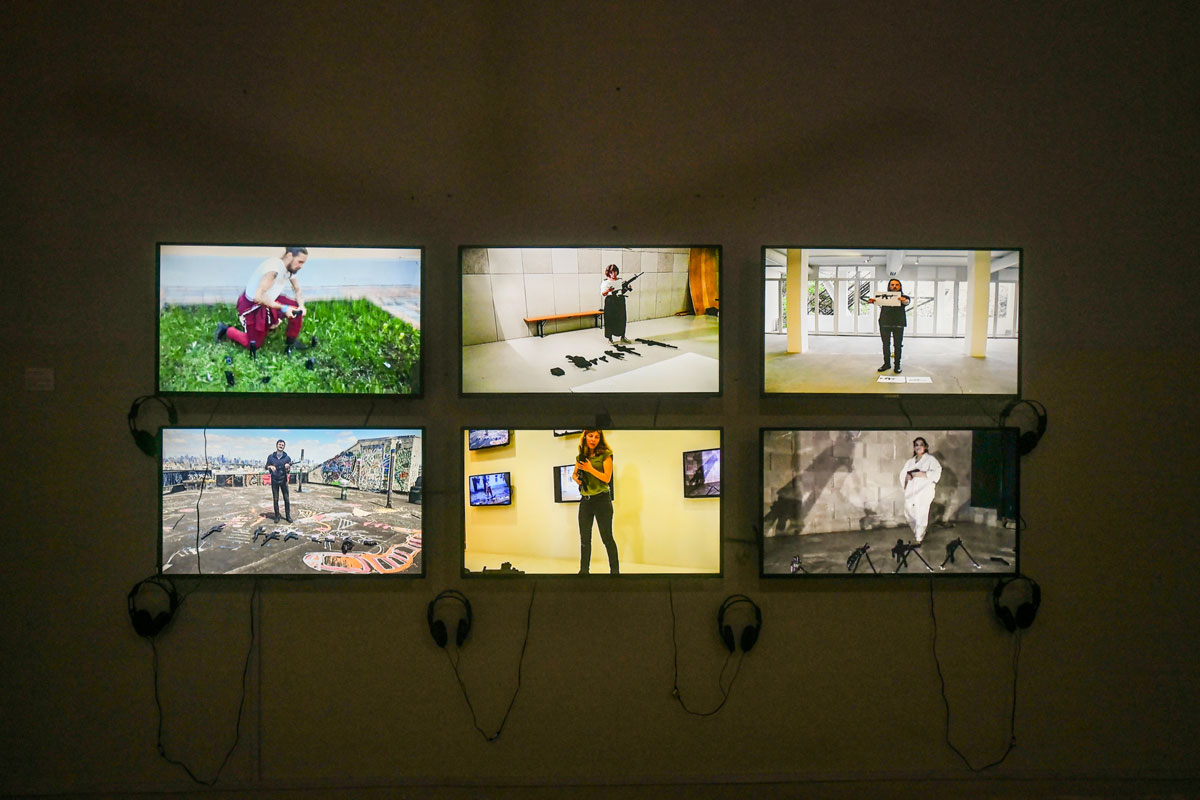
Io Combatto.
A simultaneous performance between Venice, New York, Moscow, Istanbul, Paris and Karachi
May 12th 2017, 5:30 pm, Arsenal of Venice
57th Biennale of Venice
Curated by Paolo De Grandis.

Sebastián Díaz Morales
Born in 1975 in Comodoro Rivadavia (Argentina)
Lives and works in Amsterdam (The Netherlands)
Sebastián Díaz Morales
Born in 1975 in Comodoro Rivadavia (Argentina)
Lives and works in Amsterdam (The Netherlands)
Sebastián Díaz Morales was reared in an isolated place between the Atlantic Ocean and the Patagonian Desert. He believes his upbringing led him to a particular way of perceiving reality. He uses a number of different formal strategies to create his videos, ranging from the digital manipulation of appropriated news clips to lengthy, film-like narrative works made from footage filmed by himself. Díaz Morales explores the relationship between large-scale socio-political power dynamics and individual action in works that create a sense of uneasiness for the viewer. His films are often surreal, establishing a tension between a depicted social reality and its representation in a visually abstract or phantasmagorical way. Throughout his works, multiple forms of dependence are explored, including interdependent relationships between people, the environment and social structures. Díaz Morales’ works can be found in the collections of the Centre Pompidou, Paris; Tate Modern, London; Fundación Jumex, Mexico; Sandretto Foundation, Turin; Constantini Collection, Buenos Aires; Pinault Foundation, Paris; Sammlung-Goetz, Munich; and the Fundacion de Arte Moderna, Museo Berardo, Lisbon, among others.
Pasajes I and II are the first two films in a series of four. In the two videos included in KB17, a lone man, played by Federico Zukerfeld, opens doors, climbs stairs and ladders, walks corridors and turns corners. Like a sleepwalker, he searches the interior spaces of Buenos Aires for a seemingly elusive destination. In the videos, Buenos Aires, which appears at times both shabby and elegant, reveals itself to be an endless maze in which an alternative image of the viewer can potentially materialize. As Díaz Morales states, “These works, its surroundings and characters picture at first a reality that sometimes can be interpreted as oneiric or dreamlike. Another way to see them is by thinking of them in the opposite way: The characters who populate these realms are those who envision us; I see our reality being dreamed by them and in their dreaming, shaping our world.”

Still from Pasajes II, 2013.
Digital video, HD format, 15 min.
89 cm monitor with copper taped frames
Courtesy the artist and carlier | gebauer, Berlin
Seema Nusrat
Born in 1980 in Karachi (Pakistan)
Lives and works in Karachi (Pakistan)
Seema Nusrat trained as a sculptor at the Indus Valley School of Art and Architecture, Karachi and later did her MFA from Nova Scotia College of Art and Design, Halifax, Canada. She currently teaches at the Indus Valley as Associate Professor in the Fine Art Department. Her solo shows include: “Proposals Towards a New Architecture,” Gandhara Art Gallery, Karachi in 2017; “New Urban Landscape,” Koel Gallery, Karachi in 2016; “Items of Re-Use,” Canvas Gallery, Karachi in 2013; “Resuscitate,” Rohtas Gallery, Lahore in 2008 and “Body Without Body,” VM Art Gallery, Karachi in 2007. She has attended several residencies in Europe and Asia, notably JSW Abhisaran Residency, Vijayanagar, India in 2014; Can Serrat International Artist Residency Programme, El Bruc, Spain, in August 2009; Artist in Residence Programme of Fukuoka Asian Art Museum, Fukuoka, Japan in 2009; Gasworks International Residency, London in 2008; 3 Island Workshop, Scotland in 2008; Theertha International Artists’ Workshop, Sri Lanka in 2008 and VASL Residency, Karachi in 2007.
Of her work for KB17 Seema Nusrat writes: “Barricades, entrenchments and barriers that were introduced to cordon off areas during unrest in Karachi are now an integral part of the city’s landscape. The security infrastructure that looked alien at the time of its inception has become a regular feature at public spaces and government institutions. This could evoke fear and anxiety among denizens of Karachi but it could also be intertwined with the architecture such that it becomes a design element. Containing the Metropolis is a continuation of Proposals Towards a New Architecture, one which could meet requirements of a city in conflict while maintaining design aesthetics fit for a metropolis.”

Containing the Metropolis, 2017.
Burlap bags and sand
Dimensions variable
Courtesy the artist
Seher Naveed
Born in 1984 in Quetta (Pakistan)
Lives and works in Karachi (Pakistan)
Seher Naveed was awarded a BFA from the Indus Valley School of Art & Architecture in 2007 and an MA in Fine Art from Central Saint Martins College of Art & Design in London in 2009. She has shown in various local and international exhibitions and is currently working as an Assistant Professor in the Department of Fine Art at the Indus Valley School of Art & Architecture, Karachi. She also initiated an ongoing research project called “Drawing Documents” that looks at various drawing practices as research.
Seher Naveed’s curiosity lies in temporary barricades and obstructions that are a constant feature in the urban growth of Karachi. Interested in urban geography, she views these barriers as additions, subtractions and alterations to our everyday movement. She sees these as superimposed architectural spaces that appear and disappear, slowly becoming part of everyday banal objects. Of her work on view at KB17, entitled The New Gate, the artist writes: “For the past couple of months I have been interested in documenting the gates seen in Karachi’s residential areas. I feel the city’s uncertain security situation reflects in their layered construction, making these gates function more as barriers and defenses in which we protect and barricade ourselves. These new gates of Karachi, which are ornamented with iron spikes and barbed wire, are not meant to welcome one in; in fact, they require a password, camera surveillance and credentials.”

The New Gate, 2017.
Paint on Lasani board
243.8 x 415.4 cm.
Courtesy the artist
Shahana Afaq
Born in 1991 in Karachi (Pakistan)
Lives and works in Karachi (Pakistan)
Shahana Afaq received her BFA with Distinction from the Indus Valley School of Art and Architecture, Karachi in 2015. Her work has been exhibited widely throughout Karachi, at galleries including: Canvas Gallery; FOMMA; Alliance Française; VM Gallery; Koel Gallery; and Sanat Gallery. Internationally, she is currently part of the Imago Mundi Project, ‘White Turban’ in collaboration with the Luciano Benetton Foundation, and as part of such, her work has been exhibited at the Venice Biennale and Luciano Benetton ‘Imago Mundi’ collection, as well as the 8th Cairo Festival. She also took part in the Box Print International Exchange Programme with COFA, Sydney. As a multi-medial artist, her technical practice strives to express her ideas throughout a wide-range of mixed media. Afaq describes the basis of her art practice as “Mushahadah”, which she defines as: “To look, to observe, and to gain experience with observation”, as seen in her constantly developing experiments with diverse media and aesthetics, each deliberately chosen to visually elaborate to the audience a specific experience, and how her conscious and subconscious observations have shaped this.
Afaq’s site-specific video installation, Let’s Celebrate, is a joyful expression of the spontaneity, innocence, energy and positivity that she experienced as a child. Within her work there is a phantasmagoria of different moments and sensory information that have been visually translated to create a kaleidoscopic homage to the beauty of childhood, and the nostalgia that comes with retrospection. The placement of the work, in a small, separate ceramic studio of the NJV School, provides the perfect space for Afaq’s video installation to enter into a rose-tinted reality – ‘simpler times’ – but also makes a poignant statement on the importance of art for children’s creative expression.

Let’s Celebrate, 2017.
Video installation, 3:37 min., dimensions variable
Collection of the artist
Shahid Sayeed Khan/Umer Bhatti/Shahbaz Hussain
In 2013, Shahid Sayeed Khan (b. Karachi), Umer Bhatti (b. 1983, Karachi) and Shahbaz Hussain (b. 1981, Karachi), all of whom are practising architects, began to collaboratively experiment on their own homes, using recycled and discarded materials to create artistic yet functional furniture, culminating in a group show at Faraar Gallery, Karachi. In 2014, the three concretised their collaboration in the establishment of Prometheans Studio, with the aim to blur the traditionally established lines between tools, hardware and ornamentation, realigning the relationship between form, function and sustainability. The design philosophy is to recycle materials in a manner which exposes their covert beauty, in opposition to the pervasive culture of homogenous design. Their first solo show ‘RETRONICS’ took place in Artchowk Gallery, Karachi, in February 2014, and their second solo show PROPRIOCEPTION took place at Nomad Art Gallery, Islamabad, in September 2014.
Their site-specific installation for the Karachi Biennale 2017, Forest of Hope, is a visual statement on the reality of climate change, expressed through a functional art comprised of recycled industrial material, in keeping with Prometheans Studios’ design philosophy. A densely packed bamboo ‘forest’ surrounds a chandelier made from skip-chains, gears sprockets, wheels, and other discarded materials. The sculptural installation depicts a ‘forest’ that has been impregnated and adulterated by a man-made machine symbolizing our entirely heinous role in the alarming rate of global deforestation, yet the light emitted from within the piece shines through, as glimmering rays of hope of a more sustainable future. Forest of Hope simultaneously condemns our industrialised destruction of the earth’s fragile environment, whilst also visually demonstrating the hope of an alternative future in which both industry and general society embraces sustainability.
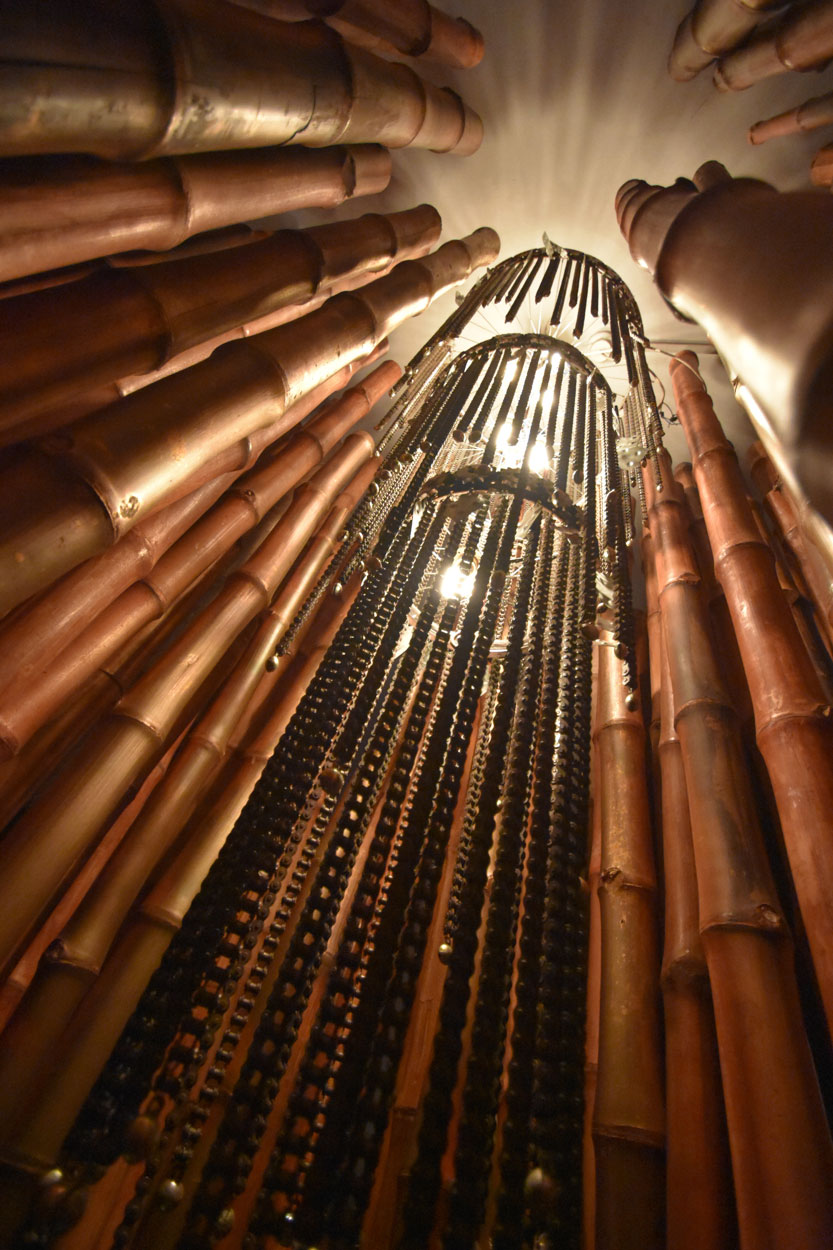
Forest of Hope, 2017.
Recycled industrial material, bamboo, lights
3 x 3 x 3 m.

Shahzia Sikander
Born in 1969 in Lahore (Pakistan)
Lives and works between New York (USA) and Seville (Spain)
Shahzia Sikander
Born in 1969 in Lahore (Pakistan)
Lives and works between New York (USA) and Seville (Spain)
Shahzia Sikander received her BFA in 1991 from the National College of Arts, Lahore, in miniature painting. Sikander received her MFA from the Rhode Island School of Design in 1995, and from 1995-1997, she participated in the CORE Program of the Glassell School of Art at The Museum of Fine Arts, Houston. Sikander has been the subject of major international exhibitions around the world, including, amongst others, MAXXI | Museo nazionale delle arti del XXI secolo, Rome (2016-17); Asia Society Hong Kong Center, Hong Kong (2016); the Guggenheim Museum, Bilbao (2015); Bildmuseet Umea, Sweden (2014); Linda Pace Foundation, San Antonio, Texas (2012-13); IKON, Birmingham (2008); Museum of Contemporary Art, Sydney (2007); Irish Museum of Modern Art, Dublin (2007); The San Diego Museum of Art, San Diego (2004); the Whitney Museum of American Art, Philip Morris/Altria Branch (2000); Hirshhorn Museum and Sculpture Garden (1999); Renaissance Society at the University of Chicago (1998); The Drawing Center (1997); The Whitney Biennale (1997); and has participated in more than 400 group shows and international art forums. Sikander has received numerous grants, fellowships and awards.
Disruption as Rapture (2016) is a 4K single-channel video animation with original music by the Pulitzer-Prize winning composer Du Yun featuring musician Ali Sethi. The work is born from selected folios of the 18th-century Gulshan-i-Ishq manuscript and is permanently installed in the South Asian Galleries of the Philadelphia Art Museum. In 2015 the museum reached out to the artist to develop a multi-dimensional work to bring the historical manuscript in their permanent collection to life. The Gulshan-i-Ishq or the Garden of Love, an epic poem and an allegorical tale, was written in 1657–58 by Nusrati, court poet to Sultan Ali Adil Shah II of Bijapur. The poem is also written in Daccani Urdu and Persian Naskh script, the language of the Muslim elite in South- Central India, a North Indian Hindu love story recast as a Sufi tale for an Islamic court. The story is a classic tale of star-crossed lovers who must face daunting challenges and painful separation before they can unite. The poet recounts this tale of connection, separation, longing, and the final union of lovers by creating a world full of lush gardens and magical beings, where the love story emerges as a metaphor for a soul’s search for, and connection with, the divine. Disruption as Rapture calls into question the philosophical and the political, with the unfolding of narrative based on shifting migratory patterns, interactions, cultural quarantine, autonomous verbal and poetic languages, and the quest for the sacred in the personal.
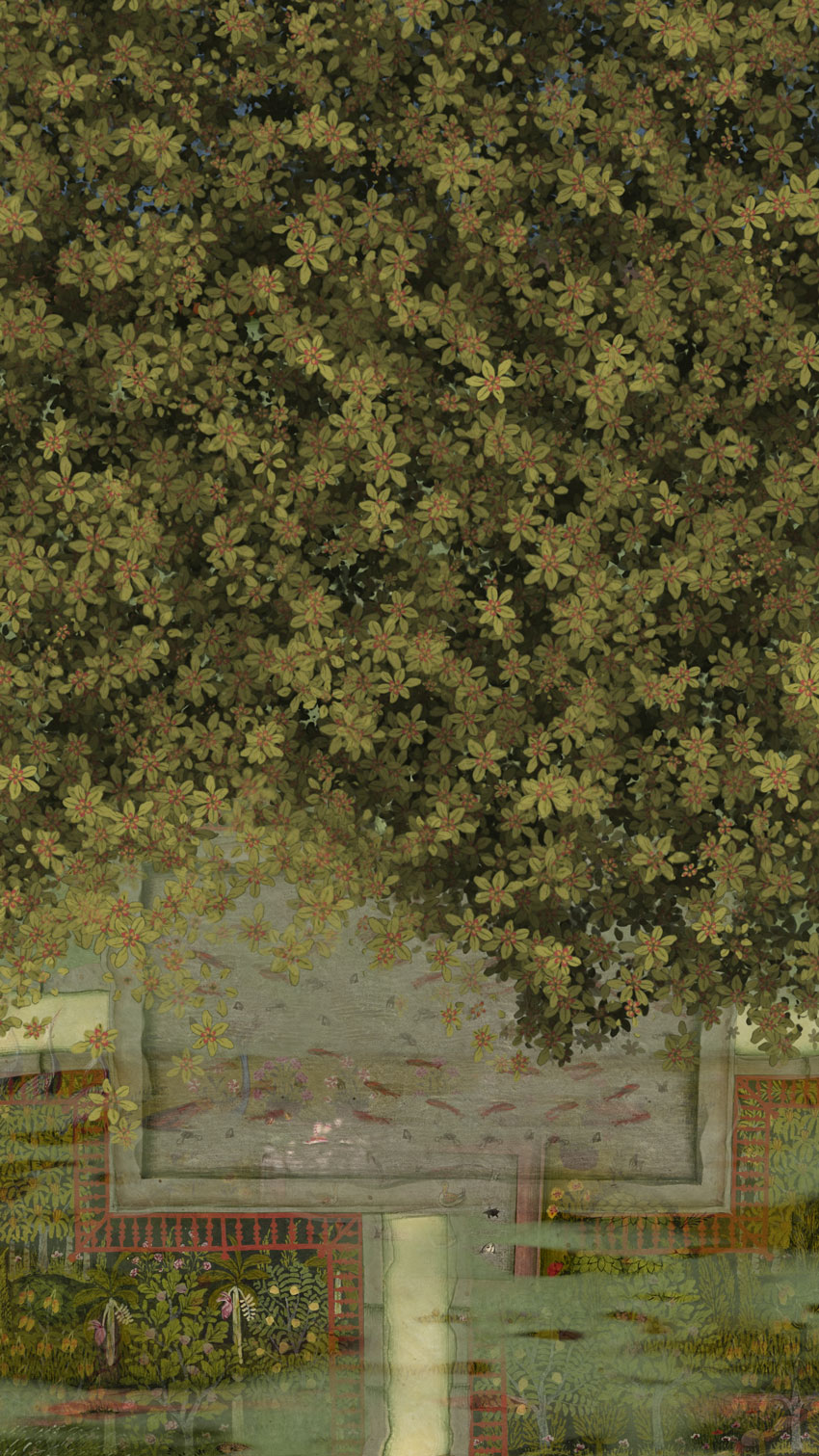
Still from Disruption as Rapture, 2016.
HD video animation with 7.1 surround sound, 10:07 min.
Music by Du Yun featuring Ali Sethi
Commissioned by the Philadelphia Museum of Art for the Permanent South Asian Galleries
Shakeel Siddiqui
Born in 1951 in Karachi (Pakistan)
Lives and works in Karachi (Pakistan)
Shakeel Siddiqui received his Diploma in Fine Art Painting from the Central Institute of Arts and Crafts, Karachi in 1975. He also studied at the Art Students’ League in New York from 1970 to 1972. At the the beginning of his career, he focused on figurative work and portraits in oil on canvas. Later, he moved on to still-life, also in oil on canvas. Since 1979, he has concentrated on super realism, also known as hyper realism. He taught at the Central Institute of Arts and Crafts, Karachi from 1986 to 1989 and at the Dubai International Art Centre from 1992 to 2004. He has had solo exhibitions of his work in Pakistan, the UAE, the UK, Canada and The Netherlands, and participated in numerous group exhibitions around the globe.
Of his work for KB17, Shakeel Siddiqui writes: “I am submitting one painting. The subject is a noticeboard. I have tried to capture the third effect of a noticeboard which everyone of us has experienced. I went through almost all the details including the lettering on the papers. Almost all the papers are white and overlapping each other (white on white) but they are still easily differentiated.”

Notice Board, 2017 (Detail)
Oil on canvas
91 x 91 cm.
Courtesy the artist
Shalalae Jamil
Born in 1978 in Karachi (Pakistan)
Lives and works in Karachi (Pakistan)
Shalalae Jamil was born and raised in Pakistan and educated at Bennington College, USA and at the School of the Art Institute of Chicago, USA. She has exhibited work in Pakistan and India, the US and the UK. She has been on the faculty of Beaconhouse National University, Lahore; National College of Arts, Lahore; and the Indus Valley School of Art and Architecture, Karachi, where she was head of the Postgraduate Diploma Course In Photography. Her work is in several private collections, including the Arts Council in Pakistan and the Devi Art Foundation in India. Using photography, film, video, installation and elements of performance, she continually investigates how perception and meaning are altered by the shifting parameters of private and public space. Sometimes poetic, but often straightforward, her work uses the generic to address unspoken aspects of shared experience.
Of her work for KB17, Shalalae Jamil writes: “The name Kodak and its visual branding have been, for the major part of the last century, synonymous with the rise and dominance of photography as a popular art form. This body of work brings attention to the brand’s signage as it appears currently in Karachi: beleaguered, fading and becoming increasingly irrelevant. Witness to an era, to the processes of change and disintegration, to the inevitable clash between old and new; the at once beautiful and distressed symbol is emblematic in the most profound way, carrying with it the past, present and future of photographic practice. It is this history and ‘now-ness’ that I grapple with, through a series of photographs that are simultaneously a tribute and a space for reflection.”

The Lock from The Kodak Project, 2017.
Photograph
187 x 140 cm.
Courtesy the artist
Sharmeen Obaid Chinoy
Born in 1978 in Karachi (Pakistan)
Lives and works in Karachi (Pakistan)
Sharmeen Obaid Chinoy is a two-time Academy Award and Emmy Award winning documentary filmmaker. In the past 16 years, she has made a dozen multi-award winning films in over 10 countries around the world. Her films include Girl in the River, Song of Lahore, Saving Face, Peace Keepers, Transgenders: Pakistan’s Open Secret and Pakistan’s Taliban Generation. Her work has aired on channels spanning four continents including HBO, CNN, PBS, Channel 4, CBC, Arte, SBS and the Discovery channel. In 2012, Time Magazine included Sharmeen in their annual list of the 100 most influential people in the world. That same year the Pakistan Government awarded her with highest civil honor “Hilal -e–Imtiaz”. In 2013, the Canadian government awarded her a Queen Elizabeth II Diamond Jubilee Medal for her work in the field of documentary films and the World Economic Forum honoured her with a Crystal Award at their annual summit in Davos. In 2017, Sharmeen was the first artist ever to co-chair the “World Economic Forum” at Davos. Born and raised in Karachi, Pakistan, Sharmeen received a Bachelor’s degree from Smith College and two Masters’ degrees from Stanford University.
Sharmeen Obaid has submitted five VR films for KB17. Virtual Reality (VR) technology is the computer generated simulation of the three-dimensional that can be interacted with in seemingly real and physical ways via specialized electronic equipment such as goggles and helmets fitted with sensors. With the launch of its newest project, Look but with Love, SOC Films is the first to bring VR technology to Pakistan. Look but with Love is a series of short films designed to promote the rich cultural history of Pakistan, champion the empowerment of women and children and evoke a sense of social responsibility and consciousness. With VR technology at their center, the films will have an immediate and sensory effect on the audience, challenging them to observe and, most importantly, question the world around them. Through these films, the audience will be exposed to the rich musical history of Sindh’s Jamshoro, the women fighters of KPK’s Nowshera, the plight of sick children in Karachi hospitals and the beautiful and often unexplored deserts of Thar.
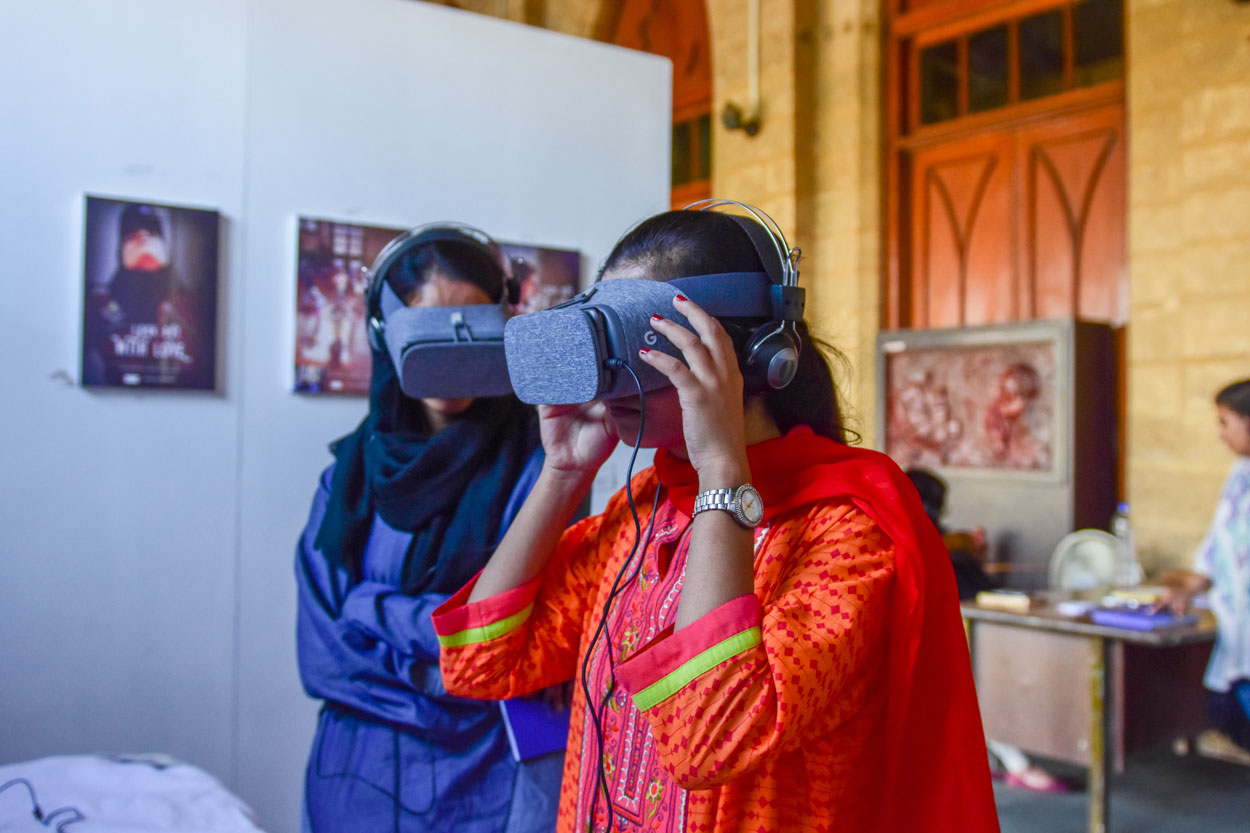
Look but with Love, 2017.
Five VR Films, 2k. Sphere 360, plays on mobile phones with a headset
Produced by SOC Films in collaboration with WITHIN & HERE BE DRAGONS
Sheba Chhachhi
Born in 1958 in Harare (Ethiopia)
Lives and works in New Delhi (India)
Sheba Chhachhi studied at Delhi University, Chitrabani, Kolkatta and the National Institute of Design, Ahmedabad. Installation Artist, activist, photographer and writer, she has exhibited widely in India and internationally including the Gwangju, Taipei, Moscow, Singapore and Havana biennales; her works are held in significant public and private collections including Tate Modern, UK, Kiran Nadar Museum, Delhi, BosePacia, New York, Singapore Art Museum, Devi Art Foundation, Delhi and National Gallery of Modern Art, India. Chhachhi has published writings, given talks and conducted workshops, research and projects relating to women, conflict, urban ecologies, visual culture and contemporary art practice in both institutional and non-formal contexts. She was Townsend Fellow at University of Berkley, 2005 and held the Mario Miranda Chair for Visual Arts at the University of Goa, India in 2015. Chhachhi was awarded the Signature Juror’s Prize for contemporary art in Asia by the Singapore Art Museum, 2011. In 2017, she was honoured with the Prix Thun for Art & Ethics, Switzerland.
Sheba Chhachhi’s lens based works investigate contemporary questions about gender, the body, the city, cultural memory and eco-philosophy, through intimate, sensorial encounters. Chhachhi began as an activist and photographer, documenting the women’s movement in India. By the 1990s, she moved to creating collaborative staged photographs, eventually turning to large multimedia installations. Her works retrieve marginal worlds: of women, mendicants, forgotten forms of labour, and often draw on pre-modern thought and visual histories to calibrate an enquiry into the contemporary moment. Chhachhi writes of her work on view at KB17: “Water has become a commodity. Today, we are beleaguered consumers trying to meet our needs in the midst of contamination and scarcity. The video reminds us of water as part of our symbolic, cultural, psychic life. Evoking pleasure, loss, and rejuvenation, the elephant, symbol of wisdom, power, fertility, becomes emblematic of cultural memory, of an eco-philosophy which has been submerged and must be recovered.”

Still from The Water Diviner, 2008.
Video projection, 183 x 244 cm, 3 min. (looped)
Courtesy the artist
Sheema Kermani
Born in 1951 in Karachi (Pakistan)
Lives and works in Karachi (Pakistan)
Sheema Kermani is a prominent theatre practitioner, activist for women’s and peace rights, a trained classical dancer, choreographer and dance teacher. She founded Tehrik-e-Niswan (Women’s Movement) in 1979. Tehrik-e-Niswan is a Cultural Action Group working to create greater awareness about women’s rights and their status in society and promote art and culture. Besides appearing on the stage, Sheema has acted in a number of popular TV plays and serials, and has performed in many countries all over the world. She has taught at the National College of Arts, Lahore and at the Indus Valley school of Art and Architecture and Szabist, Karachi and often writes on women, culture and society.
Sheema Kermani writes of her performance for KB17: “I will be presenting a dance theatre piece which I call Where Do We Come From, Where Are We and Where Are We. This is the cycle of life--a poetic visual journey, a choreographic poem, traveling through our past: a ritual of wisdom, the ancient civilisation and heritage of culture, discipline and geometry of meaning. All is destroyed but out of this debris we survive into the present bringing our memories and enter the theatre of the real – a crazy city with chaos and violence at every corner. Man/monster - woman/ wisdom – a labyrinth and confrontation between love and hatred, a spiral of life and movement to the desire of harmony, freedom and peace!”
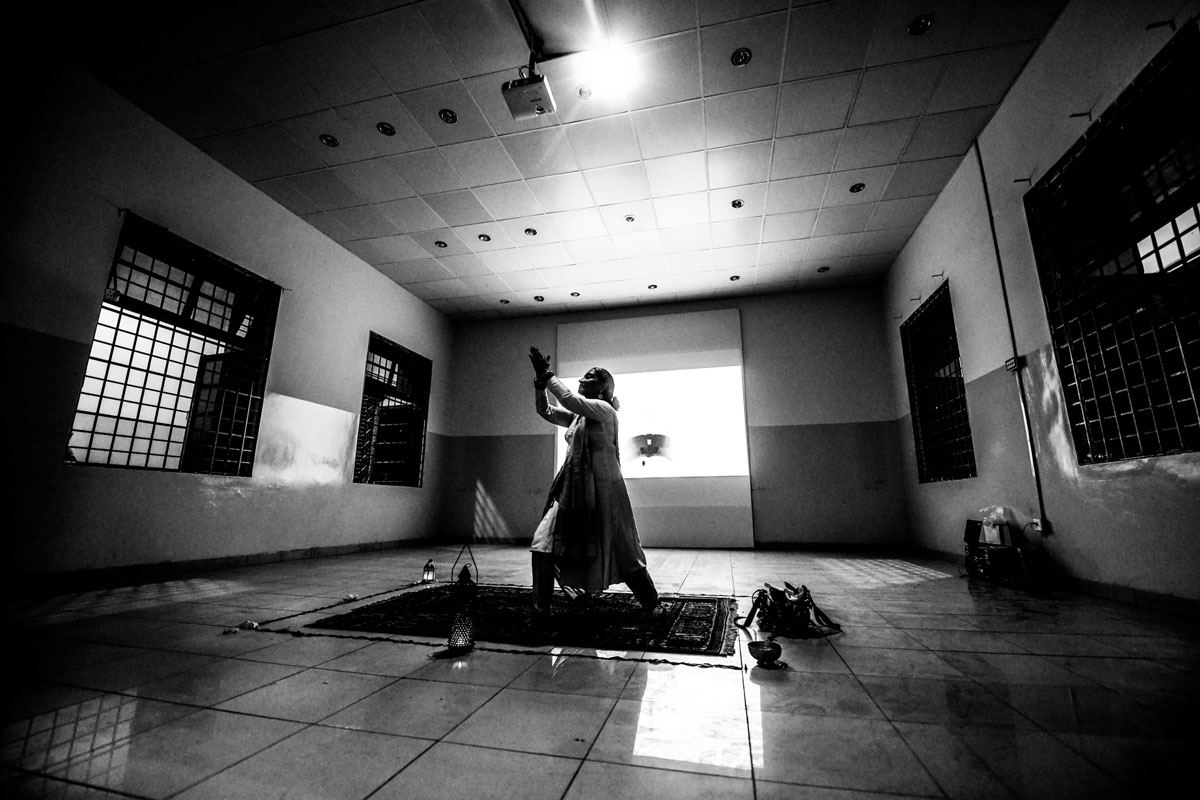
Where Do We Come From, Where Are We and Where Are We Going, 2017.
Performance
30 min.




